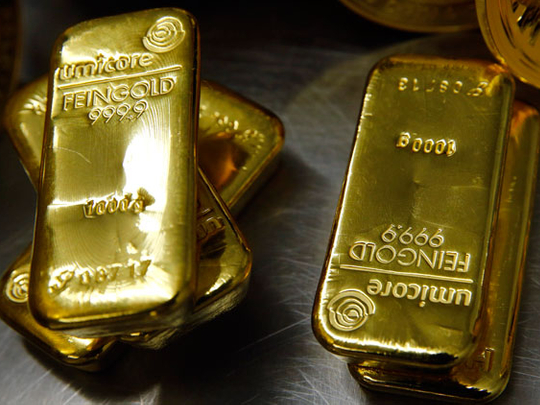
Dubai: Gold as an investment has been struggling and there seems no end to its plight.
Gold prices, which hit their lowest level in a week on Thursday, are likely to extend losses as dollar retains its strong position in the backdrop of rising rates and a trade war triggered by the United States.
International spot gold traded 0.83 per cent lower to $1,215.57 an ounce, after hitting its lowest level in 12 months of $1,214.45.
- Giovanni Staunovo | Commodities analyst at UBS Global Wealth Management’s Chief Investment Office
“We are bearish gold because of the risk of a continuation and escalation of a trade war. In this scenario, the US dollar strengthens against all currencies in the war, and that dollar strength contributes to weakening gold price. In a trade war, gold is not a safe haven,” David Donora, Head of commodities at Columbia Threadneedle Investments, told Gulf News.
Federal Reserve chair Jerome Powell reaffirmed the central bank’s plans to gradually raise interest rates “for now,” thereby helping the greenback.
- David Donora | Head of commodities at Columbia Threadneedle Investments
Gold is highly exposed to interest rates, particularly in the United States, as higher rates lift the opportunity cost of holding non-yielding assets and boost the dollar, in which gold is priced. Gold and dollar often move in opposite direction as both are considered as alternative investments.
“We believe gold could continue its downward trend if a trade agreement is reached before the conflict escalates into a bigger and more damaging dispute; we know that President Trump has a history of taking extreme positions and then moving towards negotiations, so he could agree to a last-minute compromise,” Névine Pollini, analyst, Union Bancaire Privée said.
UBP is keeping its prudent stance on gold, and expect it to trade in the range of $1,200-1,300 an ounce.
The investment and physical demand of gold, which has historically given a floor to its prices, is also not rosy.
Demand from China and India, the world’s biggest consumers of the yellow metal, has been sliding due to weak local currencies.
Gold has also been negatively impacted by ETF (Exchange Traded Funds) outflows. SPDR Gold ETF holdings of gold are now at their lowest level since August 2017, showing investors’ total lack of interest in the metal. Even the net-positioning of non-commercial account in gold futures and options is at the lowest level since early 2016.
Safe-haven demand
Gold has been void of safe-haven demand, which has historically been a main feature of the metal to which investors were attracted to.
“Financial investors did not see any need to hold gold as an insurance instrument due to the factors mentioned above (US equity markets still trade close to record highs),” said Giovanni Staunovo, commodities analyst at UBS Global Wealth Management’s Chief Investment Office.
Gold prices are yet to recover to 2014 highs of $1,900 an ounce, and have been trading 36 per cent below that level.












